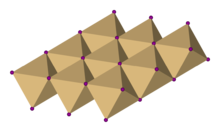Cadmium iodide

| |

| |

| |
| Names | |
|---|---|
| IUPAC name
Cadmium(II) iodide
| |
| Other names
Cadmium diiodide
| |
| Identifiers | |
3D model (JSmol)
|
|
| ChemSpider | |
| ECHA InfoCard | 100.029.294 |
| EC Number |
|
PubChem CID
|
|
| UNII | |
CompTox Dashboard (EPA)
|
|
| Properties | |
| CdI2 | |
| Molar mass | 366.22 g/mol |
| Appearance | white to pale yellow crystals |
| Density | 5.640 g/cm3, solid |
| Melting point | 387 °C (729 °F; 660 K) |
| Boiling point | 742 °C (1,368 °F; 1,015 K) |
| 787 g/L (0 °C) 847 g/L (20 °C) 1250 g/L (100 °C) | |
| Solubility | soluble in ethanol, acetone, ether and ammonia |
| -117.2·10−6 cm3/mol | |
| Structure | |
| Trigonal, hP3, space group P3m1, No. 164 | |
| octahedral | |
| Hazards | |
| GHS pictograms |   
|
| GHS Signal word | Danger |
GHS hazard statements
|
H301, H331, H351, H373, H400, H410 |
| P260, P280, P301+330+331, P310, P304+340, P311, P403+233 | |
| NFPA 704 (fire diamond) | 
3
0
0 |
| NIOSH (US health exposure limits): | |
PEL (Permissible)
|
[1910.1027] TWA 0.005 mg/m3 (as Cd)[1] |
REL (Recommended)
|
Ca[1] |
IDLH (Immediate danger)
|
Ca [9 mg/m3 (as Cd)][1] |
| Related compounds | |
Other anions
|
cadmium fluoride cadmium chloride cadmium bromide |
Other cations
|
zinc iodide mercury(II) iodide |
Except where otherwise noted, data are given for materials in their standard state (at 25 °C [77 °F], 100 kPa). | |
| Infobox references | |
Cadmium iodide is the inorganic compound with the formula CdI2. It is a white hygroscopic solid. It also can be obtained as a mono- and tetrahydrate.[2] It has few applications. It is notable for its crystal structure, which is typical for compounds of the form MX2 with strong polarization effects.
Preparation[]
Cadmium iodide is prepared by the addition of cadmium metal, or its oxide, hydroxide or carbonate to hydroiodic acid. Also, the compound can be made by heating cadmium with iodine.[2]
Crystal structure[]

In cadmium iodide the iodide anions form a hexagonal close packed arrangement while the cadmium cations fill all of the octahedral sites in alternate layers. The resultant structure consists of a layered lattice. This same basic structure is found in many other salts and minerals. Cadmium iodide is mostly ionically bonded but with partial covalent character.[3]
Cadmium iodide's crystal structure is the prototype on which the crystal structures many other compounds can be considered to be based. Compounds with any of the following characteristics tend to adopt the CdI2 structure:[citation needed]
- Iodides of moderately polarising cations; bromides and chlorides of strongly polarising cations
- Hydroxides of dications, i.e. compounds with the general formula M(OH)2
- Sulfides, selenides and tellurides (chalcogenides) of tetracations, i.e. compounds with the general formula MX2, where X = S, Se, Te
References[]
- ^ Jump up to: a b c NIOSH Pocket Guide to Chemical Hazards. "#0087". National Institute for Occupational Safety and Health (NIOSH).
- ^ Jump up to: a b F. Wagenknecht; R. Juza (1963). "Cadmium iodide". In G. Brauer (ed.). Handbook of Preparative Inorganic Chemistry, 2nd Ed. 2. NY, NY: Academic Press. p. 1096.
- ^ Greenwood, Norman N.; Earnshaw, Alan (1997). Chemistry of the Elements (2nd ed.). Butterworth-Heinemann. pp. 1211–1212. ISBN 978-0-08-037941-8.
- Cadmium compounds
- Iodides
- Metal halides
- Photographic chemicals
- Crystal structure types
